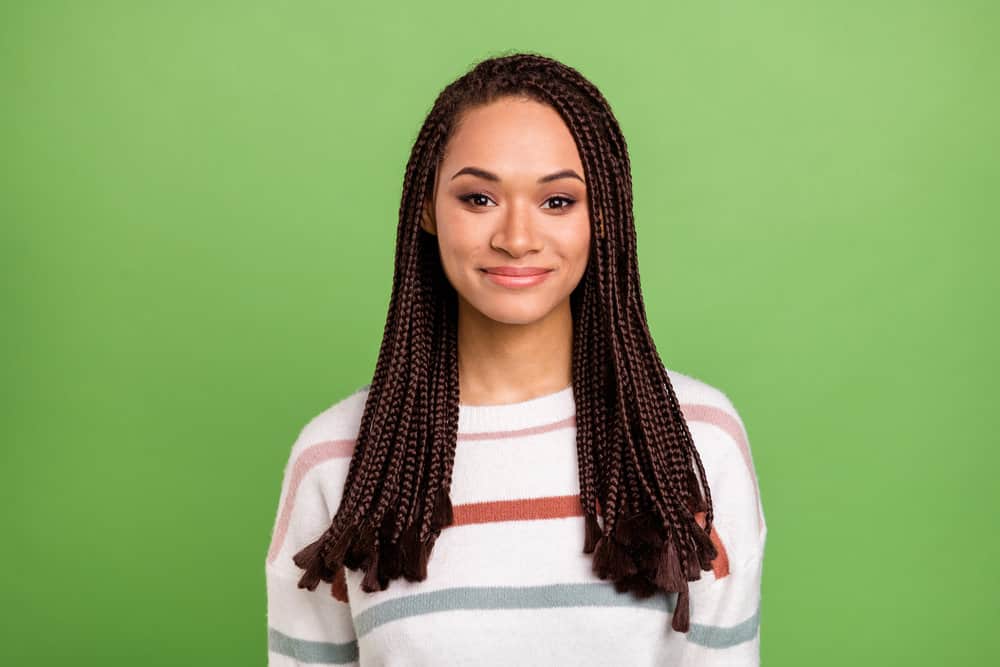
Getting your braids installed is a lengthy and often expensive process. But who doesn’t love the look and protective nature of long, flowing braids?
Unfortunately, you might leave the salon only to find that your braids are stiff and uncomfortable in the following days.
If you’re looking for solutions, you’ve come to the right place! This article will walk you through how to soften synthetic braids using some of our favorite techniques.
Table of Contents
Here’s How to Soften Synthetic Braids
Unlike human hair, synthetic hair (e.g.,

Spritz on Some Fabric Softener
One way to soften stiff braids is to spritz them with diluted fabric softener. Fabric softener is a laundry aid that coats synthetic fibers with lubricating, electrically charged chemicals.
The electrical charge makes the synthetic fibers stand up, which creates a softer, fluffier texture. Want to know the best part? This method is incredibly simple and inexpensive!
First, pour equal parts of fabric softener and warm water into a spray bottle and shake well. Then, spray your braids with the mixture.
Fabric softener isn’t exactly damaging to your hair, but you should try to keep the spray limited to just the braiding hair. Let the fabric softener sit for 10 to 15 minutes before rinsing well with warm water. Once your braids dry, they should be noticeably softer.

Co-wash Your Hair
Washing your hair is one of the quickest and easiest ways to soften stiff synthetic braids. The heat from the warm water will help soften and reshape the synthetic fibers.
Additionally, hair conditioners can help soften and relax synthetic hair.
If you want to try this method, simply saturate your hair with warm or hot water. Then, apply a generous amount of conditioner or co-wash and let it sit for around twenty minutes.
Once your time is up, rinse your hair with cool water.
Fresh braids put a lot of tension on your strands, so be careful when you dry them. Squeeze the excess water from your braids with a microfiber towel or T-shirt.
Turn your blow dryer onto a cool heat setting, and briefly dry your scalp. Once your hair is about 60 to 75% dry, turn off the dryer and let your braids air dry.

Dip Your Braids in Hot Water
Hot water might provide better results if a regular washing session isn’t cutting it. To try this method, get a large pot and boil at least four or five cups of water.
Once the water boils, remove it from the heat and let the temperature drop slightly. Next, stir a few tablespoons of apple cider vinegar into the boiling water.
The vinegar will dissolve some of the chemicals coating your synthetic hair and help make it softer. Gather your braids together and carefully dip them into the hot water.
Submerge as many braids as you can, and wait for five to ten seconds while the heat takes effect. You don’t want to wait longer than a few seconds, or your braids can start to unravel.
Carefully remove your hair from the water and use a clean towel to pat it dry. Remember, you’re working with scorching temperatures that can easily lead to burns.
So, try not to let the water drip onto your skin.
If you are unable to maneuver your hair on your own safely, ask a friend to help. They can hold the pot of water to prevent spills and get the towel ready so your hair doesn’t have a chance to drip.

How Long Does It Take for Braids to Soften?
If you’re wondering how long it will take for your braids to soften, there isn’t an easy answer. It depends on a few different factors, including the type of hair you use and the length and thickness of the braids.
Although some people can successfully soften their braids in a few hours, it usually takes two or three days.
As you wait for your braids to soften, make sure you keep your hair clean and hydrated. Try not to pull them into tight or ornate hairstyles. Instead, opt for loose, free-flowing styles that let your braids hang naturally.

How Do You Get Rid of Scalp Pain After Getting Braids?
Fresh braids can make your scalp tender, itchy, or uncomfortable even when they aren't installed tightly. You shouldn’t have to choose between a gorgeous hairstyle and being comfortable, so here are some tips to help you make your braids a little less painful.
Take a Painkiller
Did you know that there’s a type of headache specifically named after hairstyles? Ponytail headaches occur when a hair accessory or hairstyle puts too much pressure on your head.
The good news is that there are a ton of over-the-counter painkillers available.
And within just a few minutes of taking them, you should start to feel relief. You can also take the painkillers before your braiding appointment, so the process is entirely pain-free.

Let Your Hair Down
One mistake that many people make is putting their freshly installed braids into a ponytail or bun. New braids are tight and put your hair and scalp under a lot of tension.
In addition to making you uncomfortable, pulling your hair back too soon can cause breakage.
So, to play it safe, leave your braids down for the first few days after getting them done. Then, once your braids loosen, you can start experimenting with different hairstyles.
Use a Braiding Spray
Braiding sprays are a type of hair product that is specifically made to provide relief to people with braids and twists. Most braiding sprays contain a potent blend of botanicals that can soothe an inflamed scalp.
Some can even make your braids feel softer, so they don’t hurt as much.
As a bonus, braiding sprays tend to have antifungal ingredients. That will help prevent bacteria and fungi from growing in your braids.
So, if you’re looking for relief, try spritzing a braiding spray directly into your roots. Want to amp up the soothing factor even more? Try sticking your braiding spray in the fridge for a few hours.

Take Out Your Braids
We get it - no one wants to waste time and money. However, if the health of your hair and scalp is more important to you, don’t hesitate to take out any painful braids.
Pain is your scalp’s way of screaming out for help; ignoring it only increases your chances of developing breakage and hair loss. Once you take the braid or braids out, let your scalp breathe for a few days to a week
Apply some moisturizer to the area and put the braids back in your hair.
But this time, make sure they’re not installed too tightly. If you’re not a braid DIYer, find a stylist that prioritizes the health of your natural hair and scalp rather than the tightness of the braids.
So, there you have it! There are a number of different ways to soften synthetic hair . So, it's important to play around with the various methods and see which ones give you the best results.
Softening your braids is a vital part of getting them to look and feel the way you want them to. And as long as you follow the tips we’ve gone over in this article, you should be able to do it without stress or strain. Good luck!




